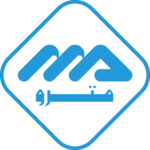Metro Algiers
| Metro Algiers | |
|---|---|

|
|

|
|
| Basic information | |
| Country |
|
| city | Algiers |
| opening | October 31, 2011 |
| operator | RATP El Djazaïr |
| owner | Entreprise Métro d'Alger (EMA) |
| Infrastructure | |
| Route length | 18.2 km |
| Gauge | 1435 mm ( standard gauge ) |
| Power system | 750 volt DC power rail |
| Stations | 19th |
| business | |
| Lines | 1 |
| Shortest cycle | <2 minutes |
| statistics | |
| Passengers | 105,557 per day, 38 million per year |
| website | |
| metroalger-dz.com | |
 Route map |
|
The Metro of Algiers is An in-building subway system in the Algerian capital. Work began in 1981 and the first section was opened on October 31, 2011.
history
In June 1981 the Algerian government decided to build an underground metro in the capital, Algiers , in order to increase mobility in the megacity and also to reduce the number of daily traffic jams. The government presented a concept that envisaged the construction of three underground lines. However, since Algeria ran into economic difficulties in 1986 due to the falling oil price , a discontinuation of the project was considered for a time.
The companies Geni Sider and Cosider, commissioned with the implementation from 1993, had great difficulties with the construction due to inexperience in this area of civil engineering. The political uncertainty in Algeria up to civil wars and terrorist attacks did the rest to delay the metro project. From 1999, the use of explosives in tunnel construction was also approved.
In 2006, the transport company EMA ( E ntreprise M étro d ' A lger ), which is also responsible for construction supervision, awarded the contract to continue building the metro to a consortium led by the German Siemens transport division ( Siemens TS ). Siemens contributed 145 million euros to the total order volume of 380 million euros and is responsible for general project management, controls, signals , communications technology , supply systems and tracks . The consortium also includes the Spanish vehicle manufacturer CAF , which supplies a total of 14 metro trains, each consisting of six wagons, and the French Vinci Construction Grands Projets , who are building the stations, the depot, ventilation and administrative buildings.
On October 31, 2011, President Abdelaziz Bouteflika opened the first route. The route is operated by RATP El Djazaïr , a subsidiary of the Paris transport company . It is calculated with 300,000 passengers per day.
route
1st construction phase (2009)
The first section of the Algiers Metro is nine kilometers long and has ten stations. The route runs from the south to the north, after which the metro follows the coastline to the west. The line connects Aïn Allah with Gué de Constantine via El-Biar in the city center of Algiers with Aïn Naadja.
The stations are named Hai el Badr , Cité Mer et Soleil , Cité Amirouche , Les Fusillés , Jardin d'Essai , Hamma , Aïssat Idir , Place du Premier-Mai , Khelifa Boukhalfa and Tafourah - Grande Poste .
The platforms of the stations are equipped with platform glass doors, as is the case with Métro Lille or the new Jubilee Line in London.
1st extension (2015)
An extension of the 1st construction phase by 4 km to the southeast was put into operation on July 5, 2015. There were four more stations: Bachdjarah - tennis , Bachdjarah , El Harrach Gare and El Harrach Center . In addition, the line crosses a motorway on a 250 m long viaduct.
Further expansion
In the medium term, the line is to be extended by 3.5 kilometers between the districts of Emir Abdelkader and Oued Koreiche in addition to the existing metro section, largely following the coastline. Six new stations are to be created.
The Algerian government and the city administration of Algiers are sticking to the earlier metro plan, so that the construction of two more metro lines in the Algerian capital can be assumed.
The second route, which is to cross with the first at the Hai el Badr and Tafourah stations , is to begin at the Grande Poste station in the city center and connect the Bab Ezzouar Annassers plateau via Badjarah and El-Harrach. If lines 1 and 2 were fully implemented, a so-called fish bubble network would arise in Algiers . A third line, which is supposed to run between Hussein Dey and Ain Allah via Annassers , would rather open up the wider, inner area of Algiers. A precise definition of the route has not yet been decided.
tram
In 2002 plans for the construction of an additional tram network were presented. An east, 30 km long line from the city center to Ain Taya and Bordj El Kiffan with 30 stops is planned, as well as a west between the city of Bab El Oued and Ain Benian (17 km, 20 stations). The plans assume up to 200,000 passengers a day. The first section went into operation in 2011.
See also
Web links
Individual evidence
- ↑ a b c First metro line in the Algerian capital begins passenger service. Siemens press release dated October 31, 2011